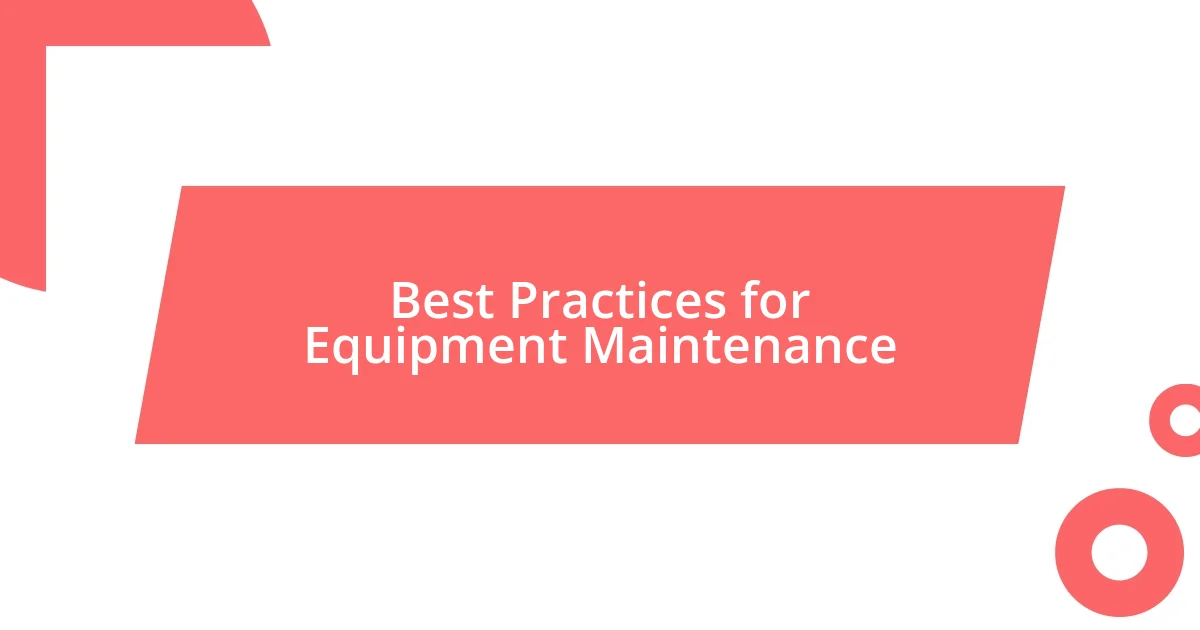Key takeaways:
- Understanding the difference between preventive and predictive maintenance is vital to reducing costly downtimes in mining operations.
- Implementing tools like CMMS and predictive maintenance technologies significantly enhances efficiency and allows for early issue detection.
- Regular inspections, thorough documentation, and fostering open communication among team members are essential best practices for effective maintenance management.

Understanding Mining Maintenance Practices
When I first stepped into the world of mining maintenance, I was struck by how critical it is to keep equipment running smoothly. It might seem straightforward, but understanding the nuances—like the difference between preventive and predictive maintenance—can make all the difference in avoiding costly downtime. Have you ever considered how much a single hour of equipment failure can impact productivity?
I remember a time when we faced unexpected machinery breakdowns just before a major project deadline. I learned firsthand that understanding the machinery’s lifecycle and performance data helps prioritize maintenance tasks effectively. This experience taught me that being proactive rather than reactive helps not only in managing costs but also in building a culture of safety and reliability within the team.
In mining maintenance, it’s vital to tailor practices to the specific environment and equipment you’re working with. Each mining site has its own set of challenges, right? These challenges may require alternative maintenance strategies or tools, which is why ongoing training and adaptation are crucial. From my experience, investing in employee training can significantly improve both team morale and operation efficiency—making everyone feel like an integral part of the process.

Key Principles of Effective Maintenance
In mining maintenance, one key principle I’ve come to appreciate is the importance of thorough documentation. Keeping detailed records of maintenance activities not only helps track what has been done but also assists in identifying patterns over time. There was a time when I overlooked this aspect and later faced difficulties diagnosing recurrent issues with our equipment. Remembering that documentation saves time and effort in the long run has stuck with me.
Another principle is scheduling maintenance during off-peak hours. I vividly recall a past project where we scheduled a major equipment inspection during the night shift. This decision allowed us to perform necessary repairs without disrupting daily operations. It taught me that being strategic about timing can minimize downtime and keep production flowing smoothly.
Effective communication among team members is critical. I learned this firsthand during my years in the field; maintaining open lines of communication can prevent misunderstandings that lead to costly mistakes. Regular team meetings to discuss ongoing issues give everyone a chance to share insights and create a sense of unity, allowing us to respond more efficiently to maintenance needs as they arise.
| Principles | Details |
|---|---|
| Documentation | Keep detailed records to track maintenance history and identify patterns. |
| Scheduling | Perform maintenance during off-peak hours to minimize disruption. |
| Communication | Maintain open lines to prevent misunderstandings and encourage teamwork. |

Tools for Enhanced Maintenance Efficiency
Tools can truly revolutionize maintenance efficiency in the mining industry. I remember the first time we incorporated a computerized maintenance management system (CMMS). Suddenly, our tracking of equipment status felt effortless. With real-time data at our fingertips, we could anticipate issues before they became major breakdowns. It was a game-changer, enabling us to streamline operations significantly.
Here are some essential tools that can optimize maintenance efficiency:
- Computerized Maintenance Management System (CMMS): Centralizes maintenance tasks and schedules, providing real-time updates and analytics.
- Predictive Maintenance Tools: Utilize sensors and data analysis to forecast equipment failures, allowing for timely interventions.
- Mobile Maintenance Applications: Enable technicians to access work orders and manuals on-site, improving response times.
- Drones: Assist in inspecting hard-to-reach areas, saving time and increasing safety during routine checks.
- 3D Laser Scanners: Allow for accurate asset assessments, helping in planning maintenance without disrupting operations.
Integrating these tools has not only enhanced our workflow but also boosted morale. Seeing my team empowered with technology made the long hours in tough conditions feel worthwhile. It’s incredible how the right tools can transform both efficiency and the overall work environment.

Best Practices for Equipment Maintenance
To ensure maintenance practices yield the best results, one crucial element is conducting regular inspections. I remember a time when we implemented a bi-weekly inspection routine on one of our major pieces of equipment. The peace of mind it provided was invaluable. Not only did we catch issues before they escalated into costly repairs, but we also developed a deeper understanding of the machinery itself. Have you ever thought about how a simple routine can prevent disasters down the line?
Another effective practice I’ve come to rely on is establishing a robust spare parts inventory. In one instance, we faced a preventable delay due to a lack of critical components on hand. After that setback, I started advocating for maintaining a well-categorized inventory of spare parts. This small change not only saved us time but also reduced stress during urgent repairs. It’s amazing how a little preparation can create a smoother workflow and boost team confidence.
Incorporating operator training as a maintenance strategy has been a revelation for me. There was a project where we noticed frequent minor issues with a specific piece of equipment, and I realized it stemmed from a lack of proper training. After organizing workshops and hands-on sessions, I noticed a remarkable improvement. The operators became more adept at recognizing early warning signs, which directly contributed to fewer breakdowns. This experience reinforced my belief that investing in training pays off in more ways than one. How would better-trained operators change the dynamics of your maintenance team?

Implementing Predictive Maintenance Strategies
Implementing predictive maintenance strategies has significantly influenced our operations. I recall a time when we started integrating sensors into our equipment. These small gadgets were game-changers; they provided timely data that allowed us to identify potential issues early on. The sense of relief when we caught an impending failure ahead of time was palpable. It not only saved us from costly downtimes but also instilled a greater sense of confidence in my team, knowing that we were ahead of the curve.
One aspect that stands out in my experience is the importance of data analysis. Adopting advanced analytics tools transformed our approach. When we analyzed historical performance, we discovered patterns that hinted at equipment stress. For example, we noticed that certain machines tended to overheat after specific operational hours. By adjusting our schedules accordingly, we not only minimized wear and tear but also streamlined our workflow. Have you ever invested the time to analyze equipment trends? The insights can be revolutionary for preventing unexpected breakdowns.
Finally, fostering a culture of collaboration around predictive maintenance is vital. I found that bringing together technicians, operators, and management increased overall buy-in for our strategies. During one meeting, a technician shared their frontline observations, which led to innovative changes in our predictive models. This newfound synergy turned what could’ve been a technician’s lone effort into a powerful team initiative. Does your team feel empowered to share their insights on predictive strategies? When everyone is on board, implementing these strategies becomes a shared mission, not just a directive.

Evaluating Maintenance Success and Improvements
Evaluating maintenance success goes beyond just analyzing data; it’s about understanding the impact of our strategies on overall equipment performance. I remember a specific project where we laid out clear metrics to gauge our maintenance efforts. Initially, it was all numbers and charts, but as we compared performance metrics before and after implementing changes, it became a story of improvement. Can numbers truly reflect the morale and productivity of a team? In this case, they did, revealing a boost in both confidence and efficiency.
Another crucial element in evaluating success is soliciting feedback from the team. During our regular meetings, I encouraged my colleagues to share their perspectives on maintenance practices. It was eye-opening to hear their thoughts; some had brilliant insights on what worked or didn’t work for them on the ground level. This dialogue didn’t just enhance our maintenance strategies; it created a culture where everyone felt their voice mattered. Have you considered how employee feedback could transform your maintenance evaluations?
Looking at failures can also be a part of the success evaluation puzzle. After an unexpected equipment failure, I initiated a thorough after-action review. Instead of placing blame, we focused on learning opportunities. This shift in mindset not only highlighted areas for improvement but also strengthened our team’s resilience. I realized that not every maintenance initiative will succeed, but how we react and adapt can become a cornerstone of our future successes. How do you approach setbacks in your maintenance evaluations? Embracing these lessons can be a game-changer for long-term improvements.















